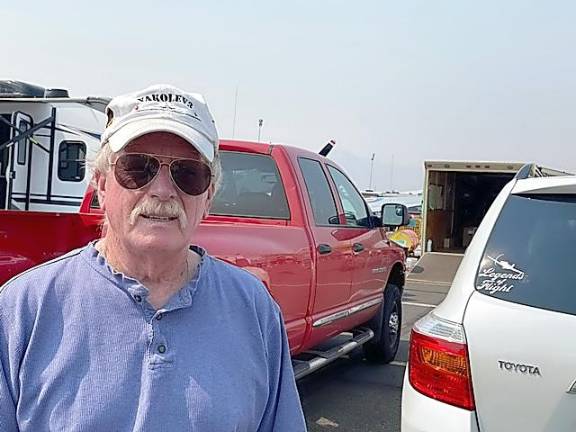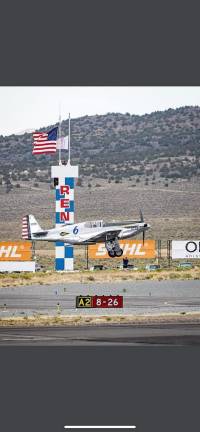Dusty Dowd, Warwick crop duster to Reno air race champ
Warwick. Warwick native John “Dusty” Dowd, Jr. took first place in the Silver Unlimited Class at Reno on Sept. 18. He now lives in Syracuse, Kansas but became intrigued with flying in Warwick.


John “Dusty” Dowd Jr., a retired crop duster who grew up in Warwick, piloted his P-51A Mustang—Shanty Irish-- at a speed of 326.470 MPH to win the 2022 National Championship Air Races’ Silver Unlimited Air Race in Reno, Nevada on Sunday, September 18. He now lives in Syracuse, Kansas,
“The races are jaw-dropping,” said Rich Bartlett, a “CPI (Certified Flight Instructor) in Sussex, NJ, who has taught the art of flying to hundreds of local pilots. Bartlett made it to Nevada to view the event. “The planes are loud and close. You feel like you’re part of the action.”
Billed as “the world’s fastest motor sport”, the Reno Air Races, officially known as the STIHL National Championship Air Races, is a multi-day event tailored to the aviation community that takes place each September. All participants are required to fly below 250 feet (many fly at just 50 feet above the ground) and hug the eight pylons that mark the roughly 60 mile course.
Dusty was born in Warwick in 1950 and raised on the Wright Family farm (his mother was a Wright). Although there appear to be no ties to Orville and Wilbur in his lineage, Dusty soon exhibited that he had the “Wright” Stuff. His uncle, Bill Flack, managed the Warwick Municipal Airport and drew Dusty’s interest in racing. Uncle Will flew in the cockpit of the most winning Formula One of all time but tragically died in it at the Cleveland Air Races in 1977.
Dusty worked at the airport in exchange for lessons. His first solo was at age 16. Also influential was his father, John Dowd Sr. who was the crop duster overflying the Pine Island region. His father passed away in 1987, leaving the Piper Cub that so many Black Dirt farmers remember to Dusty who has painstakingly restored the plane.
Off to an impressive start in Reno, Dowd took the lead and held it for seven laps, covering 54.903 miles in 10:05.48 minutes to stay well ahead of the other racers. While his flight to the finish line looked graceful and effortless--commentators praised his skill maneuvering the series of tight left turns required for the race--getting to the starting line was anything but.
“Spectators may not realize all it takes to participate in this event,” said Dowd. He said he spent over a year preparing this “warbird” for the event. He first intended to fly his Yak-11, the plane he piloted to win this same event in 2016, but a series of set-backs led him to change planes for the competition mid-stream. He focused on his Mustang P-51A instead. The P-51 Mustang is an American, long-range, single seat fighter and fighter-bomber used during World War II and the Korean War. As sole proprietor for Leprechaun Air Services Inc, also located in Syracuse, Kansas, Dowd restores planes to his own specifications which he says are rigid. The Mustang is equipped with a 1,100 Horsepower Allison V-1710-39 engine that was original to the craft. The plane is about 32 feet long, 12 feet high with a wingspan of 37 feet. He has retrofitted it for speed and performance.
The sizzling Kansas summer heat kept Dowd from working long hours in the hangar. This, in turn, limited the amount of time he had to practice. A week before leaving for Reno, Sherman Smoot, the captain of Dowd’s racing team and a longtime mentor, was killed in a crash in the plane that he intended to fly in the competition. Knowing that Smoot would have wanted the team to carry on, Dowd none-the-less flew to Reno where he faced a series of challenges.
Just days before the event, his engine caught fire on start up. Without the tool necessary to open the cowling (the cover to the engine compartment), the engine fire smoldered. Thanks to the quick work of the firefighters on the field, the plane was saved but the engine required new hoses and wiring. Parts had to be located, delivered and installed in record time.
Smoke from California fires and high, gusty winds contributed to delays and made it necessary to reschedule the series of heat races that qualify pilots for the final events.
If the story of a crop duster who becomes a champion racer sounds familiar, this may be because it echoes the plot of the Disney movie “Plane,” in which Dusty, a lowly crop duster airplane overcomes many obstacles to seize the title in a major competition. Some of the sound track for this film was recorded as real-life Dusty did low passes over the runway that was headquarters to his crop dusting services in Syracuse.
The major difference between Dowd’s personal story and the fictional Dusty is that there’s nothing “lowly” about Dowd’s crop dusting services nor in his professional background.
He earned a degree in aeronautical engineering at Wichita State University in Wichita Kansas and began air racing in 1979. He left the sport in 1991 to open Syracuse Flying Services, where he supplied crop dusting capabilities to nearby large farmers nearby. He returned to air racing a few years back, coming in third in the Silver Unlimited Race in his Yak in 2015 and taking the event in the same plane in 2016.
A sad footnote—A jet pilot was killed during the championship round on the final day of the Reno Air Races. The plane went down on lap three of six during the Jet Gold Race. The loss caused the cancellation of the remaining races and underscored the fact that the races, while breathtaking, may sometimes be life taking as well.
A week before leaving for Reno, Sherman Smoot, the captain of Dowd’s racing team and a longtime mentor, was killed in a crash in the plane that he intended to fly in the competition. Knowing that Smoot would have wanted the team to carry on, Dowd none-the-less flew to Reno where he faced a series of challenges.